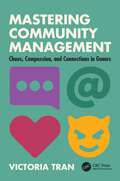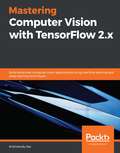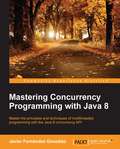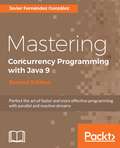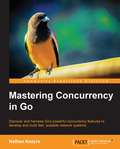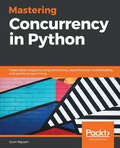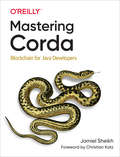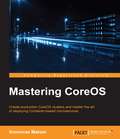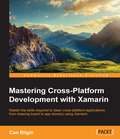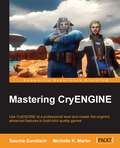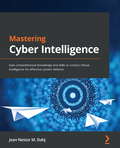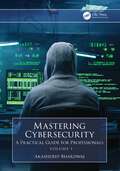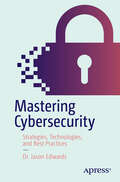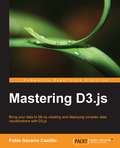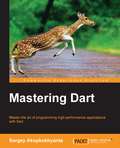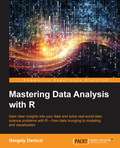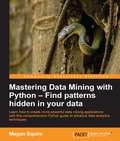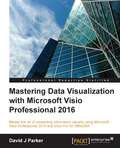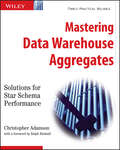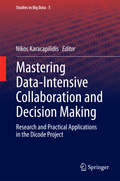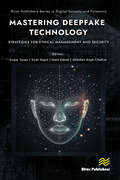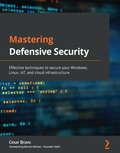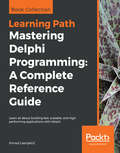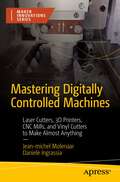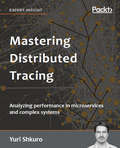- Table View
- List View
Mastering Community Management: Chaos, Compassion, and Connections in Games
by Victoria TranGame communities are inevitable – in fact, they’re one of the main features of a game. How can our online interactions be better, kinder, and more productive conversations? How can community managers design online spaces with inherent kindness in mind and create places that encourage member growth and engagement? This book provides a step-by-step strategy for creating long-term, sustainable, and intentional online spaces that matter – ones that care, grow, and connect.Using real-world experience in multiple genres of games, this book covers the fundamental concepts of designing an online community from the core basics of what it is, and then the journey from pre-launch to post-launch. With a deep dive into the practical framework for building stronger communities, it reveals the advantages and reasons why positive, cohesive, and unified spaces are more productive than their less structured counterparts. Additional engagement tips, and why these positive communities drive both business and ethical value, will be explored as an extremely relevant topic for our ever-increasing online world. The content will focus mainly on game communities and independent games, but lessons may be applied to larger studios and industries.Consumers are more inundated with typical marketing schemes than ever, and social media has only become a more powerful, yet chaotic tool over the years. Leave the high-level concepts behind to dig deep and see how community managers can tackle ever-changing algorithms and an entirely digital world. The theories and summaries will also help this book remain timeless – no matter how much social media tools or the internet applications may change, the values and core ways people understand each other and feel belonging will not. Pre-launch to post-launch guide – specifically directed toward activities and strategies for each stage of development. Review activities in key sections to help readers reflect and actively engage with the material. Case studies, step-by-step infrastructure, and background theory will help solidify the framework more practically.
Mastering Computer Vision with TensorFlow 2.x: Build advanced computer vision applications using machine learning and deep learning techniques
by Krishnendu KarApply neural network architectures to build state-of-the-art computer vision applications using the Python programming language Key Features Gain a fundamental understanding of advanced computer vision and neural network models in use today Cover tasks such as low-level vision, image classification, and object detection Develop deep learning models on cloud platforms and optimize them using TensorFlow Lite and the OpenVINO toolkit Book Description Computer vision allows machines to gain human-level understanding to visualize, process, and analyze images and videos. This book focuses on using TensorFlow to help you learn advanced computer vision tasks such as image acquisition, processing, and analysis. You'll start with the key principles of computer vision and deep learning to build a solid foundation, before covering neural network architectures and understanding how they work rather than using them as a black box. Next, you'll explore architectures such as VGG, ResNet, Inception, R-CNN, SSD, YOLO, and MobileNet. As you advance, you'll learn to use visual search methods using transfer learning. You'll also cover advanced computer vision concepts such as semantic segmentation, image inpainting with GAN's, object tracking, video segmentation, and action recognition. Later, the book focuses on how machine learning and deep learning concepts can be used to perform tasks such as edge detection and face recognition. You'll then discover how to develop powerful neural network models on your PC and on various cloud platforms. Finally, you'll learn to perform model optimization methods to deploy models on edge devices for real-time inference. By the end of this book, you'll have a solid understanding of computer vision and be able to confidently develop models to automate tasks. What you will learn Explore methods of feature extraction and image retrieval and visualize different layers of the neural network model Use TensorFlow for various visual search methods for real-world scenarios Build neural networks or adjust parameters to optimize the performance of models Understand TensorFlow DeepLab to perform semantic segmentation on images and DCGAN for image inpainting Evaluate your model and optimize and integrate it into your application to operate at scale Get up to speed with techniques for performing manual and automated image annotation Who this book is for This book is for computer vision professionals, image processing professionals, machine learning engineers and AI developers who have some knowledge of machine learning and deep learning and want to build expert-level computer vision applications. In addition to familiarity with TensorFlow, Python knowledge will be required to get started with this book.
Mastering Concurrency Programming with Java 8
by Javier Fernández GonzálezIf you are a competent Java developer with a good understanding of concurrency but have no knowledge of how to effectively implement concurrent programs or use streams to make processes more efficient, then this book is for you.
Mastering Concurrency Programming with Java 9 - Second Edition
by Javier Fernandez GonzalezMaster the principles to make applications robust, scalable and responsive About This Book • Implement concurrent applications using the Java 9 Concurrency API and its new components • Improve the performance of your applications and process more data at the same time, taking advantage of all of your resources • Construct real-world examples related to machine learning, data mining, natural language processing, and more Who This Book Is For This book is for competent Java developers who have basic understanding of concurrency, but knowledge of effective implementation of concurrent programs or usage of streams for making processes more efficient is not required What You Will Learn • Master the principles that every concurrent application must follow • See how to parallelize a sequential algorithm to obtain better performance without data inconsistencies and deadlocks • Get the most from the Java Concurrency API components • Separate the thread management from the rest of the application with the Executor component • Execute phased-based tasks in an efficient way with the Phaser components • Solve problems using a parallelized version of the divide and conquer paradigm with the Fork / Join framework • Find out how to use parallel Streams and Reactive Streams • Implement the “map and reduce” and “map and collect” programming models • Control the concurrent data structures and synchronization mechanisms provided by the Java Concurrency API • Implement efficient solutions for some actual problems such as data mining, machine learning, and more In Detail Concurrency programming allows several large tasks to be divided into smaller sub-tasks, which are further processed as individual tasks that run in parallel. Java 9 includes a comprehensive API with lots of ready-to-use components for easily implementing powerful concurrency applications, but with high flexibility so you can adapt these components to your needs. The book starts with a full description of the design principles of concurrent applications and explains how to parallelize a sequential algorithm. You will then be introduced to Threads and Runnables, which are an integral part of Java 9's concurrency API. You will see how to use all the components of the Java concurrency API, from the basics to the most advanced techniques, and will implement them in powerful real-world concurrency applications. The book ends with a detailed description of the tools and techniques you can use to test a concurrent Java application, along with a brief insight into other concurrency mechanisms in JVM. Style and approach This is a complete guide that implements real-world examples of algorithms related to machine learning, data mining, and natural language processing in client/server environments. All the examples are explained using a step-by-step approach.
Mastering Concurrency in Go
by Nathan KozyraA practical approach covering everything you need to know to get up and running with Go, starting with the basics and imparting increasingly more detail as the examples and topics become more complicated. The book utilizes a casual, conversational style, rife with actual code and historical anecdotes for perspective, as well as usable and extensible example applications. This book is intended for systems developers and programmers with some experience in either Go and/or concurrent programming who wish to become fluent in building high-performance applications that scale by leveraging single-core, multicore, or distributed concurrency.
Mastering Concurrency in Python: Create faster programs using concurrency, asynchronous, multithreading, and parallel programming
by Quan NguyenImmerse yourself in the world of Python concurrency and tackle the most complex concurrent programming problemsKey FeaturesExplore the core syntaxes, language features and modern patterns of concurrency in PythonUnderstand how to use concurrency to keep data consistent and applications responsiveUtilize application scaffolding to design highly-scalable programs Book DescriptionPython is one of the most popular programming languages, with numerous libraries and frameworks that facilitate high-performance computing. Concurrency and parallelism in Python are essential when it comes to multiprocessing and multithreading; they behave differently, but their common aim is to reduce the execution time. This book serves as a comprehensive introduction to various advanced concepts in concurrent engineering and programming.Mastering Concurrency in Python starts by introducing the concepts and principles in concurrency, right from Amdahl's Law to multithreading programming, followed by elucidating multiprocessing programming, web scraping, and asynchronous I/O, together with common problems that engineers and programmers face in concurrent programming. Next, the book covers a number of advanced concepts in Python concurrency and how they interact with the Python ecosystem, including the Global Interpreter Lock (GIL). Finally, you'll learn how to solve real-world concurrency problems through examples.By the end of the book, you will have gained extensive theoretical knowledge of concurrency and the ways in which concurrency is supported by the Python languageWhat you will learnExplore the concepts of concurrency in programmingExplore the core syntax and features that enable concurrency in PythonUnderstand the correct way to implement concurrencyAbstract methods to keep the data consistent in your programAnalyze problems commonly faced in concurrent programmingUse application scaffolding to design highly-scalable programsWho this book is forThis book is for developers who wish to build high-performance applications and learn about signle-core, multicore programming or distributed concurrency. Some experience with Python programming language is assumed.
Mastering Corda: Blockchain For Java Developers
by Jamiel SheikhMastering Corda provides you with a consistent, linear, and paced path to learning Corda and building modern enterprise-grade decentralized applications. Using this book, anyone from a complete blockchain beginner to an experienced blockchain or enterprise architect can rapidly understand and write applications like a pro while exploring the technical nuances and intricacies of the Corda platform.Corda is designed for use cases such as finance and investments, supply chain, healthcare, trade finance, insurance, and real estate that require a high-volume of transactions, scalability, and data privacy. If you have basic Java skills, this book will help you understand blockchain and show how you can get started immediately and be involved in the disruption of the future.With this book, you will:Understand Corda's value proposition and alignment with business strategies--particularly relevant to business executives and architectsDive deep into Corda's architecture and blockchain fundamentalsRapidly gain extensive knowledge of and hands-on experience with building Corda applicationsCompare and contrast Corda with Bitcoin, Ethereum, and HyperledgerEffectively prepare for the Corda certification exam and job interviews involving blockchainPerform data analytics and machine learning on Corda nodes
Mastering CoreOS
by Sreenivas MakamCreate production CoreOS clusters and master the art of deploying Container-based microservices About This Book * Confidently deploy distributed applications and effectively manage distributed infrastructure using Containers and CoreOS * Build secure, scalable CoreOS clusters to deploy distributed applications using open source technologies and industry best practices * Every concept and technology in this book is illustrated with practical examples that can be used in both development and production environments. Who This Book Is For This book is intended for Cloud application developers and Cloud infrastructure administrators. If you are looking to deploy a CoreOS cluster or you already have a CoreOS cluster that you want to manage better in terms of performance, security, and scaling, then this book is perfect for you. To follow the hands-on stuff, you need to have a Google and an AWS Cloud account and be able to run CoreOS VMs on your machine. A basic understanding of public and private clouds, Containers, Docker, Linux, and CoreOS is required. What You Will Learn * Install CoreOS on a VM, on the Cloud, and bare metal, and find out how to keep your cluster secure and up to date * Configure and troubleshoot key CoreOS services, such as etcd, systemd, and fleet, for distributed application deployment * Study container networking using CoreOS Flannel and other solutions, such as Docker libnetwork, Weave, and Calico * Explore the container filesystem and container volume management using Docker volume, NFS, GlusterFS, and Flocker * Get to know the internals of container technologies such as Docker, Rkt, and Container orchestration using Openstack, Kubernetes and Docker native solutions * Troubleshoot CoreOS cluster and Containers using monitoring and logging tools and master production techniques such as staging, security, and automation In Detail CoreOS makes Google and Amazon-style Cloud infrastructure available for anyone building their own private Cloud. This book covers the CoreOS internals and the technologies used in the deployment of container-based distributed applications. It starts with an overview of CoreOS and distributed application development while sharing knowledge on related technologies. Critical CoreOS services and networking and storage considerations for CoreOS are covered next. In latter half of the book, you will learn about Container runtime systems such as Docker and Rkt and Container Orchestration using Kubernetes. You will also find out about the integration of popular orchestration solutions such as OpenStack, the AWS Container service, and the Google Container Engine with CoreOS and Docker. Lastly, we cover troubleshooting as well as production considerations. Style and approach This is an easy-to-follow, comprehensive guide that covers both basic and advanced concepts. All topics are illustrated with practical examples that can be used in both simulation and production environments.
Mastering Cross-Platform Development with Xamarin
by Can BilginMaster the skills required to steer cross-platform applications from drawing board to app store(s) using Xamarin About This Book * Develop your Xamarin development skills with this comprehensive guide on various patterns and features so you can create elegant and high-quality applications * Create adaptive user interfaces on separate platforms without compromising the user experience and platform identity * Implement application lifecycle management concepts to manage and finalize cross-platform projects and efficiently collaborate with others Who This Book Is For This book is ideal for those who want to take their entry-level Xamarin mobile development skills to the next level to become the go-to person within their organization. To fully understand the patterns and concepts described, you should possess a reasonable level of knowledge about the core elements of Xamarin and cross-platform application development with it. What You Will Learn * Configure your environment for cross-platform projects with Xamarin * Gain memory management skills to avoid memory leaks and premature code cycles while decreasing the memory print of your applications * Employ asynchronous and parallel patterns to execute non-interactive and non-blocking processes * Create and use SQLite databases for offline scenarios * Integrate network resources with cross-platform applications * Design and implement eye-catching and reusable UI components without compromising nativity in mobile applications * Manage the application lifecycle of cross-platform development projects * Distribute Xamarin applications through public or private channels In Detail The main goal of this book is to equip you with the required know-how to successfully analyze, develop, and manage Xamarin cross-platform projects using the most efficient, robust, and scalable implementation patterns. This book starts with general topics such as memory management, asynchronous programming, local storage, and networking, and later moves onto platform-specific features. During this transition, you will learn about key tools to leverage the patterns described, as well as advanced implementation strategies and features. The book also presents User Interface design and implementation concepts on Android and iOS platforms from a Xamarin and cross-platform perspective, with the goal to create a consistent but native UI experience. Finally, we show you the toolset for application lifecycle management to help you prepare the development pipeline to manage and see cross-platform projects through to public or private release. Style and approach This is a comprehensive guide on various Xamarin features and patterns. Each topic is explained and demonstrated with code samples, which are revised in each section in an iterative manner and analyzed with available diagnostic tools to demonstrate the benefits of different patterns.
Mastering CryENGINE
by Sascha Gundlach Michelle K. MartinA comprehensive guide that covers advanced tasks performed with the CryENGINE system using interesting examples and illustrations demonstrating each of its features. This book is designed for developers who already have a basic understanding of CryENGINE and who want to take their skills to the next level. Whether you are a hobbyist developer or you are working on an AAA project, Mastering CryENGINE will help you enhance your CryENGINE proficiency.
Mastering Cyber Intelligence: Gain comprehensive knowledge and skills to conduct threat intelligence for effective system defense
by Jean Nestor DahjDevelop the analytical skills to effectively safeguard your organization by enhancing defense mechanisms, and become a proficient threat intelligence analyst to help strategic teams in making informed decisionsKey FeaturesBuild the analytics skills and practices you need for analyzing, detecting, and preventing cyber threatsLearn how to perform intrusion analysis using the cyber threat intelligence (CTI) processIntegrate threat intelligence into your current security infrastructure for enhanced protectionBook DescriptionThe sophistication of cyber threats, such as ransomware, advanced phishing campaigns, zero-day vulnerability attacks, and advanced persistent threats (APTs), is pushing organizations and individuals to change strategies for reliable system protection. Cyber Threat Intelligence converts threat information into evidence-based intelligence that uncovers adversaries' intents, motives, and capabilities for effective defense against all kinds of threats.This book thoroughly covers the concepts and practices required to develop and drive threat intelligence programs, detailing the tasks involved in each step of the CTI lifecycle. You'll be able to plan a threat intelligence program by understanding and collecting the requirements, setting up the team, and exploring the intelligence frameworks. You'll also learn how and from where to collect intelligence data for your program, considering your organization level. With the help of practical examples, this book will help you get to grips with threat data processing and analysis. And finally, you'll be well-versed with writing tactical, technical, and strategic intelligence reports and sharing them with the community.By the end of this book, you'll have acquired the knowledge and skills required to drive threat intelligence operations from planning to dissemination phases, protect your organization, and help in critical defense decisions.What you will learnUnderstand the CTI lifecycle which makes the foundation of the studyForm a CTI team and position it in the security stackExplore CTI frameworks, platforms, and their use in the programIntegrate CTI in small, medium, and large enterprisesDiscover intelligence data sources and feedsPerform threat modelling and adversary and threat analysisFind out what Indicators of Compromise (IoCs) are and apply the pyramid of pain in threat detectionGet to grips with writing intelligence reports and sharing intelligenceWho this book is forThis book is for security professionals, researchers, and individuals who want to gain profound knowledge of cyber threat intelligence and discover techniques to prevent varying types of cyber threats. Basic knowledge of cybersecurity and network fundamentals is required to get the most out of this book.
Mastering Cybersecurity: A Practical Guide for Professionals (Volume 1)
by Akashdeep BhardwajIn today’s ever‑evolving digital landscape, cybersecurity professionals are in high demand. These books equip you with the knowledge and tools to become a master cyberdefender. The handbooks take you through the journey of ten essential aspects of practical learning and mastering cybersecurity aspects in the form of two volumes.Volume 1: The first volume starts with the fundamentals and hands‑on of performing log analysis on Windows and Linux systems. You will then build your own virtual environment to hone your penetration testing skills. But defense isn’t just about identifying weaknesses; it’s about building secure applications from the ground up. The book teaches you how to leverage Docker and other technologies for application deployments and AppSec management. Next, we delve into information gathering of targets as well as vulnerability scanning of vulnerable OS and Apps running on Damm Vulnerable Web Application (DVWA), Metasploitable2, Kioptrix, and others. You’ll also learn live hunting for vulnerable devices and systems on the Internet.Volume 2: The journey continues with volume two for mastering advanced techniques for network traffic analysis using Wireshark and other network sniffers. Then, we unlock the power of open‑source intelligence (OSINT) to gather valuable intel from publicly available sources, including social media, web, images, and others. From there, explore the unique challenges of securing the internet of things (IoT) and conquer the art of reconnaissance, the crucial first stage of ethical hacking. Finally, we explore the dark web – a hidden corner of the internet – and learn safe exploration tactics to glean valuable intelligence. The book concludes by teaching you how to exploit vulnerabilities ethically during penetration testing and write pen test reports that provide actionable insights for remediation.The two volumes will empower you to become a well‑rounded cybersecurity professional, prepared to defend against today’s ever‑increasing threats.
Mastering Cybersecurity: Strategies, Technologies, and Best Practices
by Dr. Jason EdwardsThe modern digital landscape presents many threats and opportunities, necessitating a robust understanding of cybersecurity. This book offers readers a broad-spectrum view of cybersecurity, providing insights from fundamental concepts to advanced technologies. Beginning with the foundational understanding of the ever-evolving threat landscape, the book methodically introduces many cyber threats. From familiar challenges like malware and phishing to more sophisticated attacks targeting IoT and blockchain, readers will gain a robust comprehension of the attack vectors threatening our digital world. Understanding threats is just the start. The book also delves deep into the defensive mechanisms and strategies to counter these challenges. Readers will explore the intricate art of cryptography, the nuances of securing both mobile and web applications, and the complexities inherent in ensuring the safety of cloud environments. Through meticulously crafted case studies tailored for each chapter, readers will witness theoretical concepts' practical implications and applications. These studies, although fictional, resonate with real-world scenarios, offering a nuanced understanding of the material and facilitating its practical application. Complementing the knowledge are reinforcement activities designed to test and solidify understanding. Through multiple-choice questions, readers can gauge their grasp of each chapter's content, and actionable recommendations offer insights on how to apply this knowledge in real-world settings. Adding chapters that delve into the intersection of cutting-edge technologies like AI and cybersecurity ensures that readers are prepared for the present and future of digital security. This book promises a holistic, hands-on, and forward-looking education in cybersecurity, ensuring readers are both knowledgeable and action-ready. What You Will Learn The vast array of cyber threats, laying the groundwork for understanding the significance of cybersecurity Various attack vectors, from malware and phishing to DDoS, giving readers a detailed understanding of potential threats The psychological aspect of cyber threats, revealing how humans can be manipulated into compromising security How information is encrypted and decrypted to preserve its integrity and confidentiality The techniques and technologies that safeguard data being transferred across networks Strategies and methods to protect online applications from threats How to safeguard data and devices in an increasingly mobile-first world The complexities of the complexities of cloud environments, offering tools and strategies to ensure data safety The science behind investigating and analyzing cybercrimes post-incident How to assess system vulnerabilities and how ethical hacking can identify weaknesses Who this book is for: CISOs, Learners, Educators, Professionals, Executives, Auditors, Boards of Directors, and more.
Mastering D3.js
by Pablo Navarro CastilloIf you are a software developer working with data visualizations and want to build complex data visualizations, this book is for you. Basic knowledge of D3 framework is expected. With real-world examples, you will learn how to structure your applications to create enterprise-level charts and interactive dashboards.
Mastering Dart
by Sergey AkopkokhyantsIf you are an application developer who has experience with Dart and want to develop reusable and robust code in Dart, then this book is for you. You are expected to have a basic knowledge of core elements and applications.
Mastering Data Analysis with R
by Gergely DarócziIf you are a data scientist or R developer who wants to explore and optimize your use of R's advanced features and tools, this is the book for you. A basic knowledge of R is required, along with an understanding of database logic.
Mastering Data Mining with Python – Find patterns hidden in your data
by Megan SquireLearn how to create more powerful data mining applications with this comprehensive Python guide to advance data analytics techniques About This Book * Dive deeper into data mining with Python - don't be complacent, sharpen your skills! * From the most common elements of data mining to cutting-edge techniques, we've got you covered for any data-related challenge * Become a more fluent and confident Python data-analyst, in full control of its extensive range of libraries Who This Book Is For This book is for data scientists who are already familiar with some basic data mining techniques such as SQL and machine learning, and who are comfortable with Python. If you are ready to learn some more advanced techniques in data mining in order to become a data mining expert, this is the book for you! What You Will Learn * Explore techniques for finding frequent itemsets and association rules in large data sets * Learn identification methods for entity matches across many different types of data * Identify the basics of network mining and how to apply it to real-world data sets * Discover methods for detecting the sentiment of text and for locating named entities in text * Observe multiple techniques for automatically extracting summaries and generating topic models for text * See how to use data mining to fix data anomalies and how to use machine learning to identify outliers in a data set In Detail Data mining is an integral part of the data science pipeline. It is the foundation of any successful data-driven strategy - without it, you'll never be able to uncover truly transformative insights. Since data is vital to just about every modern organization, it is worth taking the next step to unlock even greater value and more meaningful understanding. If you already know the fundamentals of data mining with Python, you are now ready to experiment with more interesting, advanced data analytics techniques using Python's easy-to-use interface and extensive range of libraries. In this book, you'll go deeper into many often overlooked areas of data mining, including association rule mining, entity matching, network mining, sentiment analysis, named entity recognition, text summarization, topic modeling, and anomaly detection. For each data mining technique, we'll review the state-of-the-art and current best practices before comparing a wide variety of strategies for solving each problem. We will then implement example solutions using real-world data from the domain of software engineering, and we will spend time learning how to understand and interpret the results we get. By the end of this book, you will have solid experience implementing some of the most interesting and relevant data mining techniques available today, and you will have achieved a greater fluency in the important field of Python data analytics. Style and approach This book will teach you the intricacies in applying data mining using real-world scenarios and will act as a very practical solution to your data mining needs.
Mastering Data Visualization with Microsoft Visio Professional 2016
by David J ParkerMaster the art of presenting information visually using Microsoft Visio Professional 2016 and Visio Pro for Office365 About This Book * A complete guide to data visualization with Microsoft Visio Professional 2016 * Visualize information to meet the needs of your business * Get the quick way to learn Microsoft Visio 2016 Who This Book Is For This book is aimed at the departmental-level business intelligence professional or Microsoft Office power-user who wants to create data diagrams with Microsoft Visio that can accurately represent business information visually. What You Will Learn * Add external data from a variety of data sources * Represent information with data graphics * Create custom data-like shapes * Export data from structured diagrams * Present information graphics to non-Visio users * Automate visualizations from data * Develop custom templates and code for others In Detail Microsoft Visio Professional is a data visualization application that is used by many different market sectors and many different departments to represent information visually, from network infrastructure to organization charts, from process diagrams to office layouts. Starting off with a brief introduction to Vision Professional 2016 and then moving on to data storage, linking data to shapes, and working with SQL Server to create a solid foundation. Then we'll cover topics such as refreshing data, working with geographical data, working with various graphics, and diagrams, and more. Finally, you'll find out how to deploy custom stencils, templates, and code. Style and approach This book has real life examples that will let you explore all the new features of Microsoft Visio 2016 and apply them in your daily life.
Mastering Data Warehouse Aggregates: Solutions for Star Schema Performance
by Christopher AdamsonThis is the first book to provide in-depth coverage of star schema aggregates used in dimensional modeling-from selection and design, to loading and usage, to specific tasks and deliverables for implementation projects Covers the principles of aggregate schema design and the pros and cons of various types of commercial solutions for navigating and building aggregates Discusses how to include aggregates in data warehouse development projects that focus on incremental development, iterative builds, and early data loads
Mastering Data-Intensive Collaboration and Decision Making
by Nikos KaracapilidisThis book reports on cutting-edge research carried out within the context of the EU-funded Dicode project, which aims at facilitating and augmenting collaboration and decision making in data-intensive and cognitively complex settings. Whenever appropriate, Dicode builds on prominent high-performance computing paradigms and large data processing technologies to meaningfully search, analyze, and aggregate data from diverse, extremely large and rapidly evolving sources. The Dicode approach and services are fully explained and particular emphasis is placed on deepening insights regarding the exploitation of big data, as well as on collaboration and issues relating to sense-making support. Building on current advances, the solution developed in the Dicode project brings together the reasoning capabilities of both the machine and humans. It can be viewed as an innovative "workbench" incorporating and orchestrating a set of interoperable services that reduce the data intensiveness and complexity overload at critical decision points to a manageable level, thus permitting stakeholders to be more productive and effective in their work practices.
Mastering Deepfake Technology: Strategies for Ethical Management and Security (River Publishers Series in Digital Security and Forensics)
by Swati Gupta Mohit Kukreti Sanjay Taneja Abhishek Singh ChauhanThis book offers a comprehensive exploration of the profound challenges and opportunities presented by deepfake technology across industries, society, and governance. It delves into the multifaceted impacts of synthetic media, examining its potential to reshape corporate trust, economic stability, and public discourse while emphasizing strategies to build resilience and ethical frameworks.Key themes include the role of intellectual capital in safeguarding corporate reputation, the risks of deepfake fraud in financial markets, and the implications for insurance, banking, and fintech sectors. Through cross-disciplinary analyses, the book unravels the disruptive influence of deepfakes on political affairs, economic policies, and corporate transparency.Highlighting real-world case studies, it addresses workplace resilience, data-driven decision-making, and the intersection of deepfake technology with marketing innovation and job satisfaction. From social media marketing to public trust and privacy concerns, the book offers actionable insights for navigating the ethical dilemmas posed by synthetic media.With a focus on collaboration across disciplines, the book equips readers with strategies for mitigating risks, promoting media literacy, and leveraging AI responsibly. Mastering Deepfake Technology is an essential guide for academics, professionals, and policymakers seeking to understand and address the complexities of this emerging frontier.
Mastering Defensive Security: Effective techniques to secure your Windows, Linux, IoT, and cloud infrastructure
by Cesar Bravo Darren KitchenAn immersive learning experience enhanced with technical, hands-on labs to understand the concepts, methods, tools, platforms, and systems required to master the art of cybersecurityKey FeaturesGet hold of the best defensive security strategies and toolsDevelop a defensive security strategy at an enterprise levelGet hands-on with advanced cybersecurity threat detection, including XSS, SQL injections, brute forcing web applications, and moreBook DescriptionEvery organization has its own data and digital assets that need to be protected against an ever-growing threat landscape that compromises the availability, integrity, and confidentiality of crucial data. Therefore, it is important to train professionals in the latest defensive security skills and tools to secure them. Mastering Defensive Security provides you with in-depth knowledge of the latest cybersecurity threats along with the best tools and techniques needed to keep your infrastructure secure.The book begins by establishing a strong foundation of cybersecurity concepts and advances to explore the latest security technologies such as Wireshark, Damn Vulnerable Web App (DVWA), Burp Suite, OpenVAS, and Nmap, hardware threats such as a weaponized Raspberry Pi, and hardening techniques for Unix, Windows, web applications, and cloud infrastructures. As you make progress through the chapters, you'll get to grips with several advanced techniques such as malware analysis, security automation, computer forensics, and vulnerability assessment, which will help you to leverage pentesting for security.By the end of this book, you'll have become familiar with creating your own defensive security tools using IoT devices and developed advanced defensive security skills.What you will learnBecome well versed with concepts related to defensive securityDiscover strategies and tools to secure the most vulnerable factor – the userGet hands-on experience using and configuring the best security toolsUnderstand how to apply hardening techniques in Windows and Unix environmentsLeverage malware analysis and forensics to enhance your security strategySecure Internet of Things (IoT) implementationsEnhance the security of web applications and cloud deploymentsWho this book is forThis book is for IT professionals, including systems administrators, programmers, IT architects, solution engineers, system analysts, data scientists, DBAs, and any IT expert looking to explore the fascinating world of cybersecurity.Cybersecurity professionals who want to broaden their knowledge of security topics to effectively create and design a defensive security strategy for a large organization will find this book useful. A basic understanding of concepts such as networking, IT, servers, virtualization, and cloud is required.
Mastering Delphi Programming: Learn all about building fast, scalable, and high performing applications with Delphi
by Primož GabrijelčičUse structural, behavioral, and concurrent patterns in Delphi to skillfully develop applications Key Features Delve into the core patterns and components of Delphi to enhance your application's design Learn how to select the right patterns to improve your program's efficiency and productivity Discover how parallel programming and memory management can optimize your code Book Description Delphi is a cross-platform Integrated Development Environment (IDE) that supports rapid application development for most operating systems, including Microsoft Windows, iOS, and now Linux with RAD Studio 10.2. If you know how to use the features of Delphi, you can easily create scalable applications in no time. This Learning Path begins by explaining how to find performance bottlenecks and apply the correct algorithm to fix them. You'll brush up on tricks, techniques, and best practices to solve common design and architectural challenges. Then, you'll see how to leverage external libraries to write better-performing programs. You'll also learn about the eight most important patterns that'll enable you to develop and improve the interface between items and harmonize shared memories within threads. As you progress, you'll also delve into improving the performance of your code and mastering cross-platform RTL improvements. By the end of this Learning Path, you'll be able to address common design problems and feel confident while building scalable projects. This Learning Path includes content from the following Packt products: Delphi High Performance by Primoz Gabrijelcic Hands-On Design Patterns with Delphi by Primoz Gabrijelcic What you will learn Understand parallel programming and work with the various tools included with Delphi Explore memory managers and their implementation Leverage external libraries to write better-performing programs Keep up to date with the latest additions and design techniques in Delphi Get to grips with various modern multithreading approaches Break a design problem down into its component parts Who this book is for This Learning Path is for intermediate-level Delphi programmers who want to build robust applications using Delphi features. Prior knowledge of Delphi is assumed.
Mastering Digitally Controlled Machines: Laser Cutters, 3D Printers, CNC Mills, and Vinyl Cutters to Make Almost Anything (Maker Innovations Series)
by Daniele Ingrassia Jean-michel MolenaarTake control of your machine building and production processes with computer-run tools to safely use, or even build, a durable machine for use in your garage or even a startup company. This book provides best practices for laser cutters, 3D printers, CNC mills, vinyl cutters, and more. You'll begin by learning the history of digitally controlled tools, as well as how they work and what materials you can use with them. With this knowledge, you won’t just learn how to make common machines work, you’ll go to the next level and build your own machine—whether that be a plasma cutter or a CNC milling machine.You will learn how they use these tools to create amazing products, art, and even new machines! You’ll also find handy overviews of tools, software, and materials to use in a reference appendix. After reading Mastering Digitally Controlled Machines you’ll be able to create something for yourself, your community, or your company.What You'll LearnUse accessible computer-controlled machines safely to make anything you want to buildFit the right tool and materials with the right projectsBuild your own CNC machine custom tailored to your project’s needs Who This Book Is ForPeople who want to understand how accessible computer-controlled tools work and build any kind of product themselves. Makerspaces, Fab Labs, and similar spaces will benefit. And people who want to create prototypes and products for themselves or their company/ startup, or to start creating prototypes without much prior knowledge.
Mastering Distributed Tracing
by Yuri ShkuroAny developer interested in testing large systems will find this book very revealing and in places, surprising. Every microservice architect and developer should have an insight into distributed tracing, and the book will help them on their way. System administrators with some development skills will also benefit. No particular programming language skills are required, although an ability to read Java, while non-essential, will help with the core chapters.
